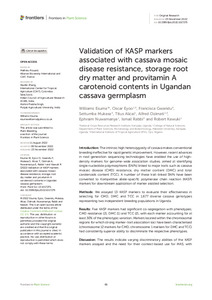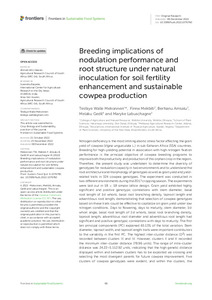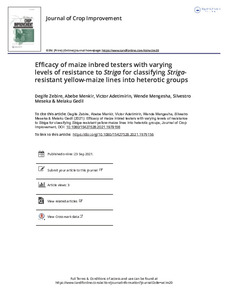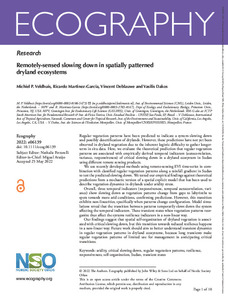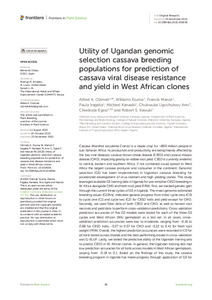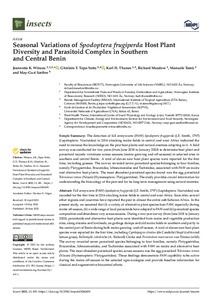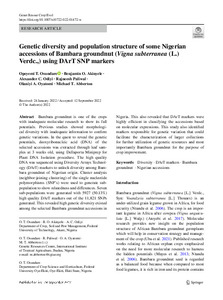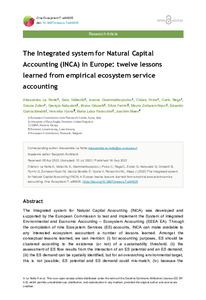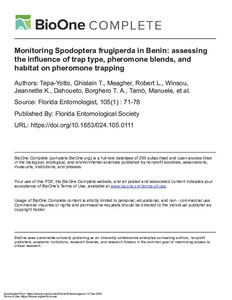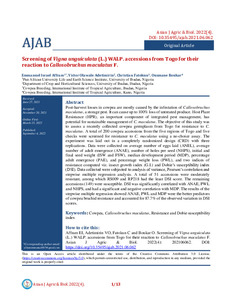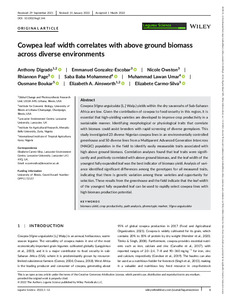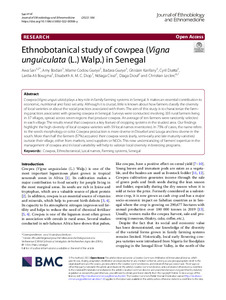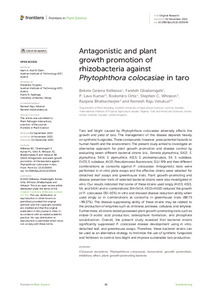Welcome to the International Institute of Tropical Agriculture Research Repository
Journal and Journal Articles: Recent submissions
Now showing items 461-480 of 5286
-
Estimating genetic gains for tolerance to stress combinations in tropical maize hybrids
(2022-12-08)Maize is a strategic food crop in sub-Saharan Africa. However, most maize growing tropical savannas particularly in West and Central African experience the occurrence of frequent droughts and Striga infestation, resulting in 30–100% yield losses. This production zones need maize cultivars that combine tolerance to the two stresses. IITA in collaboration with national partners has thus employed a sequential selection scheme to incorporate both drought tolerance and Striga resistance in topical maize ... -
Validation of KASP markers associated with cassava mosaic disease resistance, storage root dry matter and provitamin A carotenoid contents in Ugandan cassava germplasm
(2022-11-23)Introduction The intrinsic high heterozygosity of cassava makes conventional breeding ineffective for rapid genetic improvement. However, recent advances in next-generation sequencing technologies have enabled the use of high-density markers for genome-wide association studies, aimed at identifying single nucleotide polymorphisms (SNPs) linked to major traits such as cassava mosaic disease (CMD) resistance, dry matter content (DMC) and total carotenoids content (TCC). A number of these trait-linked ... -
Breeding implications of nodulation performance and root structure under natural inoculation for soil fertility enhancement and sustainable cowpea production
(2022-12-08)Nitrogen deficiency is the most limiting abiotic stress factor affecting the grain yield of cowpea (Vigna unguiculata L.) in sub-Saharan Africa (SSA) countries. Breeding for high-yielding potential in association with high nitrogen fixation performance is the principal objective of cowpea breeding programs to improve both the productivity and production of this orphan crop in the region. Therefore, the present study was undertaken to determine the diversity of genotypes for nodulation capacity in ... -
Efficacy of maize inbred testers with varying levels of resistance to Striga for classifying Striga-resistant yellow-maize lines into heterotic groups
(2021-09-23)Identifying efficient testers for separating maize (Zea mays L.) inbred lines into heterotic groups can facilitate the development of superior hybrids. Striga-resistant yellow-maize inbred lines developed at the International Institute of Tropical Agriculture (IITA) do not have well established heterotic groups. This study was conducted to identify efficient testers for classifying yellow-maize inbred lines into heterotic groups. Thirty Striga-resistant inbred lines were crossed with three testers ... -
Remotely-sensed slowing down in spatially patterned dryland ecosystems
(2022-10)Regular vegetation patterns have been predicted to indicate a system slowing down and possibly desertification of drylands. However, these predictions have not yet been observed in dryland vegetation due to the inherent logistic difficulty to gather longer-term in situ data. Here, we evaluate the theoretical prediction that regular vegetation patterns are associated with empirically derived temporal indicators (autocorrelation, variance, responsiveness) of critical slowing down in a dryland ecosystem ... -
Utility of Ugandan genomic selection cassava breeding populations for prediction of cassava viral disease resistance and yield in West African clones
(2022-11-23)Cassava (Manihot esculenta Crantz) is a staple crop for ~800 million people in sub-Saharan Africa. Its production and productivity are being heavily affected by the two viral diseases: cassava brown streak disease (CBSD) and cassava mosaic disease (CMD), impacting greatly on edible root yield. CBSD is currently endemic to central, eastern and southern Africa, if not contained could spread to West Africa the largest cassava producer and consumer in the continent. Genomic selection (GS) has been ... -
Seasonal variations of Spodoptera frugiperda host plant diversity and parasitoid complex in southern and central Benin
(2022)Fall armyworm (FAW) Spodoptera frugiperda (J.E. Smith, 1797) (Lepidoptera: Noctuidae) was recorded for the first time in 2016 attacking maize fields in central and west Africa. Soon after, several other regions and countries have reported the pest in almost the entire sub-Saharan Africa. In the present study, we assumed that (i) a variety of alternative plant species host FAW, especially during maize off-season, (ii) a wide range of local parasitoids have adapted to FAW and (iii) parasitoid species ... -
Genotype-environment-interaction and stability of root mealiness and other organoleptic properties of boiled cassava roots
(2022-12-03)Genetic enhancement of cassava aimed at improving cooking and eating quality traits is a major goal for cassava breeders to address the demand for varieties that are desirable for the fresh consumption market segment. Adoption of such cassava genotypes by consumers will largely rely not only on their agronomic performance, but also on end-user culinary qualities such as root mealiness. The study aimed to examine genotype × environment interaction (GEI) effects for root mealiness and other culinary ... -
Genetic diversity and population structure of some Nigerian accessions of Bambara groundnut (Vigna subterranea (L.) Verdc.,) using DArT SNP markers
(2022-09-24)Bambara groundnut is one of the crops with inadequate molecular research to show its full potentials. Previous studies showed morphological diversity with inadequate information to confirm genetic variations. In the quest to reveal the genetic potentials, deoxyribonucleic acid (DNA) of the selected accessions was extracted through leaf samples at 3 weeks old, using Dellaporta Miniprep for Plant DNA Isolation procedure. The high quality DNA was sequenced using Diversity Arrays Technology (DArT) ... -
Yield stability of east African highland cooking banana 'Matooke' hybrids
(2022-12-08)East African banana (Musa sp.) breeding efforts have focused mainly on enhancing ‘Matooke’ productivity through the development of high-yielding, pathogen-resistant cultivars with adequate stability to contribute to regional food security. Before a breeding program can recommend promising cultivars for release, they must pass the sensory screens; be evaluated in the target population environments; and the data analyzed for yield, adaptability, and stability. Twenty-four primary and secondary ... -
The Integrated system for Natural Capital Accounting (INCA) in Europe: twelve lessons learned from empirical ecosystem service accounting
(2022-09-16)The Integrated system for Natural Capital Accounting (INCA) was developed and supported by the European Commission to test and implement the System of integrated Environmental and Economic Accounting – Ecosystem Accounting (SEEA EA). Through the compilation of nine Ecosystem Services (ES) accounts, INCA can make available to any interested ecosystem accountant a number of lessons learned. Amongst the conceptual lessons learned, we can mention: (i) for accounting purposes, ES should be clustered ... -
Monitoring Spodoptera frugiperda in Benin: assessing the influence of trap type, pheromone blends, and habitat on pheromone trapping
(2022-12-12)The fall armyworm, Spodoptera frugiperda (J. E. Smith) (Lepidoptera: Noctuidae), has now become a pest of global concern. Originally known to be endemic to the Western Hemisphere, its first detection in Africa was followed by spectacular outbreaks and spread to almost all sub-Saharan countries. The rapid incursion of S. frugiperda on maize (Zea mays L.; Poaceae) fields in Africa highlighted a crucial need for a comprehensive assessment of integrated pest management strategies in most smallholder ... -
Data-driven similar response units for agricultural technology targeting: an example from Ethiopia
(2022-07-25)Ethiopia has heterogeneous topographic, climatic and socio-ecological systems. Recommendations of agricultural inputs and management practices based on coarse domains such as agro-ecological zones (AEZ) may not lead to accurate targeting, mainly due to large intra-zone variations. The lack of well-targeted recommendations may contribute to the underperformance of promising technologies. Therefore, there is a need to define units where similar environmental and biophysical features prevail, based ... -
Phenotyping cowpea for seedling root architecture reveals root phenes important for breeding phosphorus efficient varieties
(2022-02)Cowpea (Vigna unguiculata L. Walp.) is a key climate-resilient legume for food security, especially in sub-Saharan Africa. Cowpea yields are limited by edaphic stresses including drought and low phosphorus (P) availability. Identifying genotypes with advantageous root phenotypes can facilitate breeding for improved yield in marginal environments. We evaluated 50 elite genotypes from African and U.S. sources for seedling root architecture and root hair length and density. Significant genotypic ... -
Screening of Vigna unguiculata (L.) WALP. accessions from Togo for their reaction to Callosobruchus maculatus F.
(2022-09-04)Post-harvest losses in cowpea are mostly caused by the infestation of Callosobruchus maculatus, a storage pest. It can cause up to 100% loss of untreated produce. Host Plant Resistance (HPR), an important component of integrated pest management, has potential for sustainable management of C. maculatus. The objective of this study was to assess a recently collected cowpea germplasm from Togo for resistance to C. maculatus. A total of 200 cowpea accessions from the five regions of Togo and five ... -
Cowpea leaf width correlates with above ground biomass across diverse environments
(2022-03-21)Cowpea (Vigna unguiculata [L.] Walp.) yields within the dry savannahs of Sub-Saharan Africa are low. Given the contribution of cowpea to food security in this region, it is essential that high-yielding varieties are developed to improve crop productivity in a sustainable manner. Identifying morphological or physiological traits that correlate with biomass could assist breeders with rapid screening of diverse germplasm. This study investigated 23 diverse Nigerian cowpea lines in an environmentally ... -
Ethnobotanical study of cowpea (Vigna unguiculata (L.) Walp.) in Senegal
(2022)Cowpea (Vigna unguiculata) plays a key role in family farming systems in Senegal. It makes an essential contribution to economic, nutritional and food security. Although it is crucial, little is known about how farmers classify the diversity of local varieties or about the social practices associated with them. The aim of this study is to characterize the farming practices associated with growing cowpea in Senegal. Surveys were conducted involving 335 rural farmers living in 37 villages, spread ... -
Antagonistic and plant growth promotion of rhizobacteria against Phytophthora colocasiae in taro
(2022)Taro leaf blight caused by Phytophthora colocasiae adversely affects the growth and yield of taro. The management of this disease depends heavily on synthetic fungicides. These compounds, however, pose potential hazards to human health and the environment. The present study aimed to investigate an alternative approach for plant growth promotion and disease control by evaluating seven different bacterial strains (viz., Serratia plymuthica, S412; S. plymuthica, S414; S. plymuthica, AS13; S. ... -
Diversity and taxonomy of the fern genus Vandenboschia Copel. (Hymenophyllaceae, Polypodiidae) in the Afro-Malagasy region and description of a new species
(2022)Vandenboschia radicans (supposedly Neotropical and African), V. speciosa (supposedly European and Macaronesian) and V. gigantea (supposedly from western Indian Ocean) are morphologically close species and often confused in collections and in floras. Moreover, the status of African populations is still strongly debated. We undertook to combine morphological, morphometrics and molecular phylogenetic analyses, on these three species, by also including the Neotropical V. collariata, morphologically ... -
Genotype X environment interaction and stability analysis in upland rice (Oryza sativa L.) varieties in Ethiopia
(2022)Determination of the genotype x environment interaction (GEI) and stability of upland rice varieties for grain yield provides the basis to identify high-yielding and stable upland rice varieties across different environments and to delineate and identify rice mega environments in Ethiopia. Twenty rice varieties were laid out in a randomized complete block design with three replications and evaluated across six locations that represent the major rice growing agro-ecologies in the country. The ...


